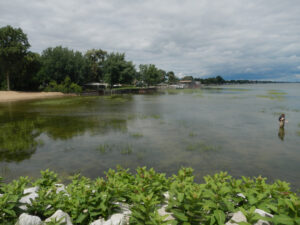Contaminants from anthropogenic actions dominate urban watersheds. The effects of these contaminants are largely unknown though early studies have found many are linked to human and fish health complications. These contaminants are often referred to as contaminants of emerging concern (CECs) because recent research warns that current levels of these contaminants may have long-term impacts on aquatic systems.

Sampling on Lake St. Clair, July 29, 2013. (Credit: NOAA via Flickr Public Domain)
The Laurentian Great Lakes basin contains approximately 84% of North America’s surface freshwater and supports more than 30 million people. Over nine metropolitan centers are supported by the Great Lakes, and these heavily developed centers have a major impact on contributing to anthropogenic drivers in the urban watershed.
These drivers include CECs like those found in synthetic sweeteners, antimicrobials, pharmaceuticals, pesticides, stimulants and polyfluoroalkyl substances. A 2023 study published in the Journal of Great Lakes Research sought to determine the environmentally-relevant concentration and distribution of persistent (or pseudo-persistent) CECs in the Lake Huron to Erie corridor.
Methods
Some of the CECs are both hydrophobic and hydrophilic, meaning that sampling needed to occur throughout the water column. Samples were collected over two years at multiple locations in the Lake Huron to Lake Erie corridor to investigate more than 150 CECs. Many CECs are considered to be indicators of waste in the aquatic environment as well as being a marker of historic pollution due to how long the compounds remain in the system.
Per- and polyfluoroalkyl substances (PFAS) are a large group of synthetic compounds that are used in household and industrial applications—more importantly, they are resistant to degradation, leading them to earn the term forever chemicals.
Conversely, pharmaceutical and personal care products (PPCPs) and pesticides are so commonly released into waterways that they are considered to be pseudo-persistent. The persistence of PPCPs are dependent on “prescribed, land use, water flow rate, and susceptibility to metabolism, biotransformation, wastewater treatment processes, sorption, microbial degradation, and other degradation processes.”1
Surface water samples were analyzed for PPCPs, pesticides, and PFAS. The study took a limited number of sediment samples which were analyzed for PFAS. Sampling occurred Spring (May) and Fall (October) of 2018-2019 at six sites in the Lake Erie to Lake Huron corridor. Sites 1 through 6 were located in the following areas (exact coordinates are available in the full study):

A wildly colorful Wednesday evening on the shore of Port Elgin. (Credit: PebblePicJay via Flickr CC BY 2.0)
- Clinton River mouth
- Lake St. Clair Metropark
- Northeast Belle Isle
- Southwest Belle Isle
- Rouge River mouth
- Detroit River International Wildlife Refuge/Trenton Channel
Results
Fifty compounds were detected at the parts per billion or parts per trillion levels from the sediment and water samples. Regarding representation amongst contaminants, synthetic sweeteners accounted for 55.7% of the cumulative concentration of all compounds, then pesticides at 27.5%, pharmaceuticals at 11.7% and stimulants at 3.5%.
Fourteen compounds were found consistently in the samples: “acesulfame-potassium, sucralose, sulfamethoxazole, acetaminophen, lidocaine, atenolol, gemfibrozil, iohexol, atrazine, diaminochlorotriazine, deethyl-atrazine, deisopropylatrazine, 2,4-Dichlorophenoxyacetic acid, and caffeine.” 1 Compound mixtures downstream were increasingly complex, indicating that the downstream portions of the Lake Huron to Erie corridor are wastewater effluent-dominated. In contrast, the Lake St. Clair aquatic region is influenced by a mixed urban, suburban, and agricultural landscape.
The results of the study provide greater insight into the concentrations of these contaminants in the Laurentian Great Lakes basin and can be used for future evaluations of the health of the region. Furthermore, this research provides a comprehensive list of CECs present in the Lake Huron to Lake Erie corridor, an area critical for recreation, sustenance/subsistence, transportation, wildlife habitat and as a source of drinking water.
Source:
- Bridget B. Baker, Alex S. Haimbaugh, F. Gianluca Sperone, Destiny M. Johnson, Tracie R. Baker. Persistent contaminants of emerging concern in a great lakes urban-dominant watershed. Journal of Great Lakes Research, Volume 48, Issue 1, 2022, Pages 171-182, ISSN 0380-1330, https://doi.org/10.1016/j.jglr.2021.12.001.







